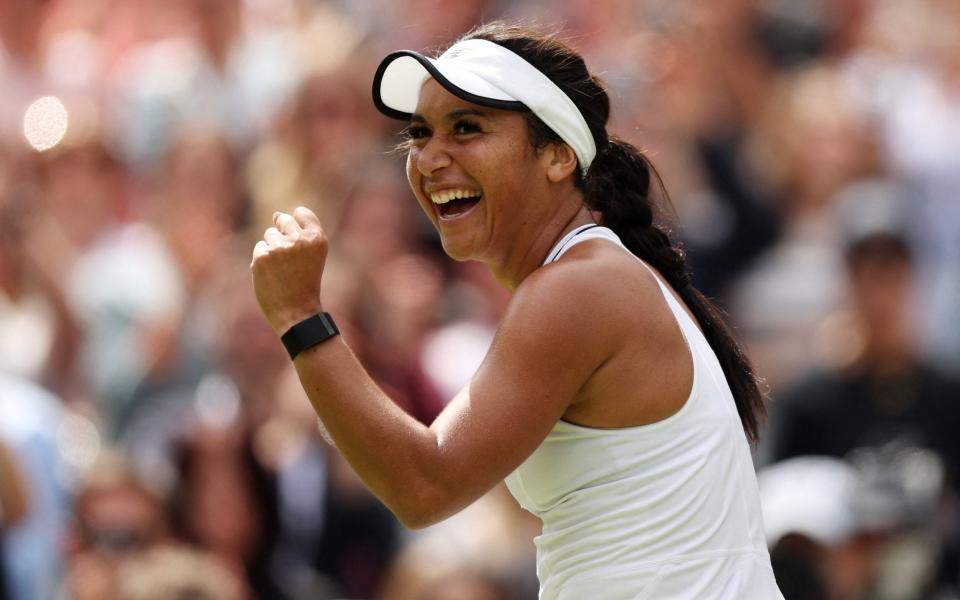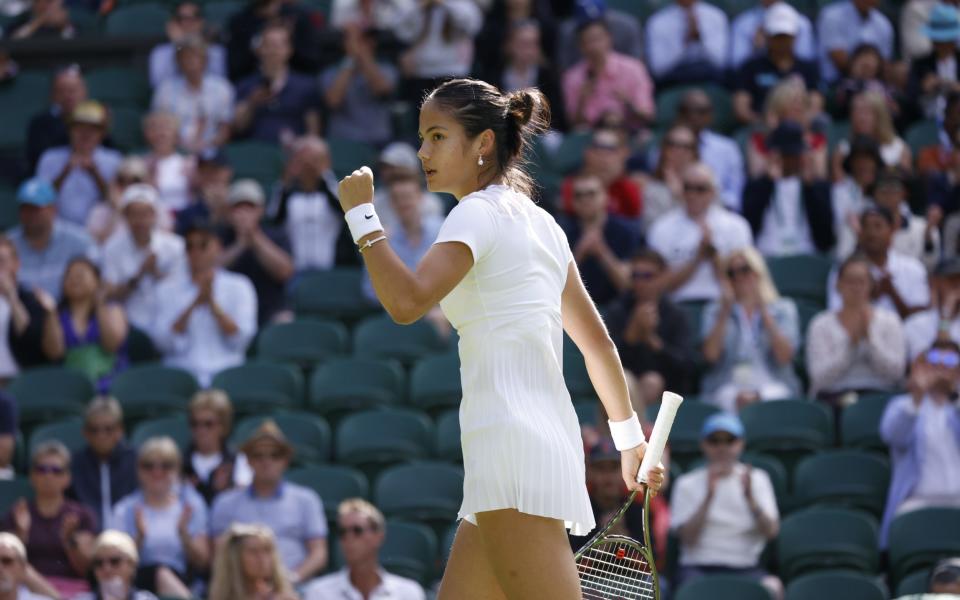Hurrah! The fresh hopes of Wimbledon have arrived

For a while, this year’s Wimbledon was beginning to look a little bleak - what with Emma Raducanu knocked out and Andy Murray and his bionic hip faltering in the second round to American slugger John Isner. And that, it seemed, was that: our two past Grand Slam winners gone, and the 9th seed Cameron Norrie the nation’s sole focus. Many feared we were doomed to fixate upon the machinations of the Centre Court roof until Wimbledon drew to a merciful close.
But then out of nowhere emerged a hitherto little-known 25-year-old from Leicestershire called Katie Boulter who pulled off one of the biggest upsets of the tournament, beating the former world number one and last year’s runner-up Karolína Plíšková. Boulter, a 5ft11ins wildcard ranked 118th in the world, came back from a set down to demolish her Czech rival. Wimbledon surged with fresh hope.
That wasn’t our only reason to keep tuning in. On Friday, Guernsey-born Heather Watson smashed her way into the final 16 for the first time in her career. The 30-year-old - who won the mixed doubles title in 2016 but has struggled in her singles career - had again seemed destined to fall at the first week hurdle, having previously reached the third round three times. She had slipped to 121st in the world rankings and this year marks her 12th Wimbledon.
Yet she saw off Slovenia’s Kaja Juvan in two sets to earn her place in Wimbledon’s coveted second week. It was the dream end to a tricky few days that had seen her forced to play singles on each day of the first five, after her late-scheduled matches kept being stopped due to failing light. “They're trying to kill me,” she joked about Wimbledon’s bosses, after she had to return to court after just four hours sleep to play Juvan.
Boulter has had a rather more sombre week. In her post-match interview on Thursday, she dedicated her triumph to her beloved grandmother, Jill, a regional tennis champion who had passed away just two days previously. Her family had not broken the news to Boulter until after her first round victory. Mary Berry, who was in the royal box, wiped away a tear.
Boulter’s boyfriend, 23-year-old Australian Alex De Minaur, made it through to the third round on the same day. When interviewed on court following his victory (ironically over British hopeful Jack Draper) the 19th seed heaped praise on his girlfriend, saying: “Before we talk about my match, can we just talk about Katie Boulter today?”
If it sounds like the making of a film script, well it’s already been done. The questionable 2004 romcom, Wimbledon, starring Paul Bettany and Kirsten Dunst, tells the story of a journeyman British tennis player who falls in love with a fellow pro and triumphs in the final. What Hollywood misunderstands, though, is that we don’t actually need our tennis heroes to win; just to offer a glimmer of hope.
Perhaps it is the fact that the tournament always coincides with the time of year when the nascent summer seems to peter out into perma-drizzle. Or that come July one begins to hear the first murmurings that half the year has already passed. Wimbledon is crucial for our collective national psyche – so long as we have a stake in the game.
Boulter grew up in the Leicestershire village of Woodhouse Eaves (she still lives in the county), where she started playing aged four, against her older brother James. Her grandfather, Brian - who was in the stands to watch her victory - is an inventor who made his name developing anti-theft tags used in clothing stores. “He is literally my idol,” Boulter recently said.
Her mother, Sue, is a former junior GB international who twice captained Leicestershire to the County Cup before becoming a coach. “When Katie was tiny, she would be waiting at the side of the court while I was coaching, desperate to have a go,” recalls Sue, who is divorced from Boulter’s father, David.
She won the first tournament she ever entered: the Leicestershire under 10s when she was five. At eight, she was selected to represent Great Britain at junior level and in 2011, aged 14, reached the final of the prestigious Orange Bowl tournament in the US. As a teenager she was also diagnosed with chronic fatigue, a condition that for a while left her struggling to get out of bed and has dogged her senior career. To compound matters in April 2019 she suffered a spinal stress fracture during a match which ruled her out for the rest of the year. “I’ve had enough adversity to last a long time,” she told an interviewer last year.
Heather Watson, who now lives in south London, has had to learn to build resilience. Her mother, Michelle, who is from Papua New Guinea, was in the stands on Friday to watch her daughter’s victory - and Heather has spoken of the racism and death threats she has consequently experienced as a player.

“It's just so disappointing and sad. It's usually when I lose a match and mostly from men who have gambled on me to win. They pick on my race,” she told one newspaper.
She began playing aged seven at her local club in Guernsey, where both her parents were members (she has a half-brother, Adam, and two half-sisters, Stephanie and Julie). “I used to follow them down as a toddler and just watch them," she has recalled. Not everyone was happy, however - Watson had been a promising swimmer and her father, Ian, to whom she is close, recounted how “they were distraught at the swimming club when she chose to concentrate on tennis.”
At 12, she moved to Florida with Michelle to train at the Nick Bollettieri tennis academy, where alumni include Maria Sharapova and Andre Agassi, becoming the US Open girls singles champion in 2009, aged 17. In 2013, a nasty bout of a glandular fever forced her to miss two months of playing and robbed her of a potential Wimbledon seeding.
Since then, the headlines have tended to be about her love life just as much as her tennis (despite having won nine titles, a mix of singles and doubles), as she has dated British tennis hopefuls Phil Stephens and Lloyd Glasspool. She had been in a relationship with Irish EFL striker Courtney Duffus, who she met at the 2019 Wimbledon finals, but confirmed their split in May.
But adversity has also given Watson and Boulter perspective. Outside of tennis both are known to be avid fans of Love Island. Watson has called herself a TikTok “obsessive” and regularly posts videos of her fitness routines and dancing. Boulter plays the piano and during lockdown volunteered for Age UK, calling on elderly people trapped at home to offer support. She is also a keen supporter of her local football team Leicester City - themselves no strangers to fairytale victories.
As her profile has risen to become the British No.3 - Watson is No.4 - she has modelled for Nike, appeared in Vogue and in 2019 was signed by sports management company KIN Partners, which also has David Beckham on its books. Watson, who is sponsored by New Balance, has similarly modelled - collaborating with the British Fashion Council.
While Watson split with her touring coach, Alex Ward, at the start of the year and it’s unclear who’s now heading up her team, Boulter is coached by the likes of Jeremy Bates and Nigel Sears, the father of Andy Murray’s wife Kim.
And yet before we all get too carried away, it is worth pointing out that both players are now in uncharted territory. Today, Boulter faces France’s Harmony Tan, who dispatched Serena Williams in the first round. Watson will play No.97 Jule Niemeier, from Germany, on Sunday.
There are still other British names in the mix. Norrie is also in the fourth round, while wildcard Liam Broady faces none other than Boulter’s boyfriend, De Minaur, in the third.
But following the wins of their careers it is Watson and Boulter, who the nation will be cheering on this weekend. Arise the fresh hopes of SW19.
Additional reporting Lilia Sebouai
Tennis dress envy: Why everyone’s talking about Emma and Katie's on court look
Emma Raducanu and Katie Boulter may have had very different results this week but as the two Brits everyone was watching, one thing that didn’t go amiss was that they were wearing the exactly the same tennis dress. As you’d expect for players on this level the NikeCourt Dri-FIT is no ordinary dress. Crucially, it combines ultra-modern technology with a breathable top and a retro-cut skirt that’s reminiscent of the sort of flirty country-club tennis dresses women wore in the ‘70s.

And yes, the tailoring creates a very flattering silhouette, but the design is undoubtedly performance-first. Bonded vertical seams on the front mimic the look of a corset (and offer support), but with none of the restriction, and a stretchy mesh on the upper chest allows for all-important ventilation, while also giving players extra room to move during serves and volleys. Dri-FIT technology moves sweat away from the skin - which will be even more important if Boulter is still in the tournament when a heatwave hits London next week. The dress doesn’t come with underwear, although most players tend to pair it with white cycling shorts.
On the fashion side of things, the asymmetrical, pleated skirt is probably the most memorable part of the design - it comes up short in the front, while the pleats flare in the back as the players run for the ball, making it somewhat reminiscent of the Miu Miu mini every young fashionista wanted to wear last summer…


